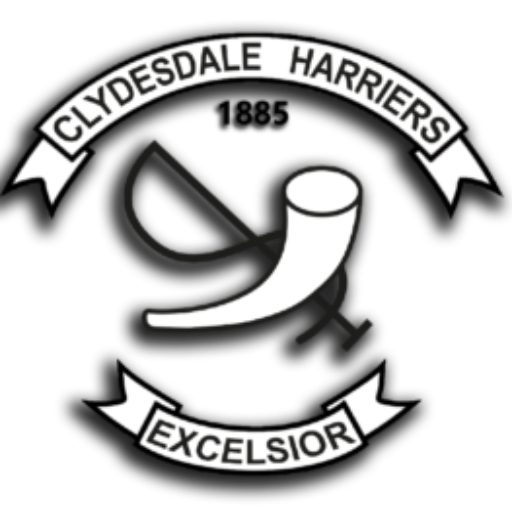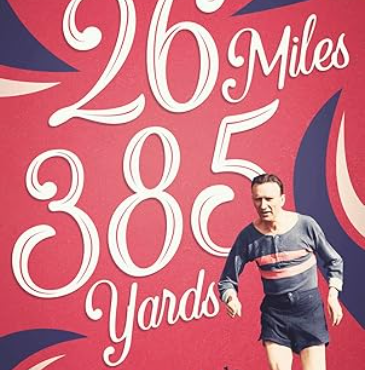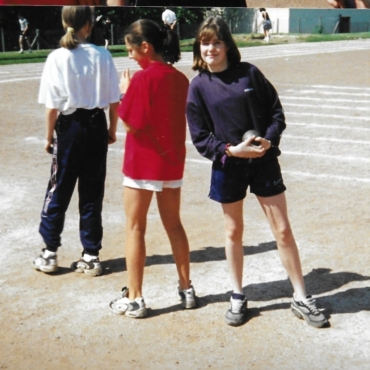
Brian Edridge, Christine Menhennet and Ian Murphy
Clydesdale Harriers have always been involved in developments and new initiatives in Scottish athletics. We became the first open athletics club in Scotland to last for any length of time when we were founded in May 1885 and were the first club in Scotland to encourage and develop a Junior Men’s section in the late 1880’s. The Clydesdale Harriers National Cross-Country Championships was the first to have a championship for that age group. After the second world war, we organised and ran the Youth Ballot Team Race for Under 17 athletes. It was first run in 1946 and was supported by many, many champions and champions to be. Starting in Killer’s Lane (so called because of the slaughterhouse there) it went through Barnes Street and back finishing where it began.

Eddie Sinclair of Springburn winning the Youths race in Killers Lane from Billy Goodwin of Bellahouston Harriers: Both became Senior International athletes.
Later, we were the club to propose a Boy’s race at the National Cross-Country Championships and it was carried. As far as road racing was concerned, we were the club to introduce the Balloch to Clydebank 12 miles as a club championship event, it became a Dunbartonshire Association confined event before becoming an open race and then a half marathon. David Bowman, Willie Howie and Eric Paton were key members of the Scottish Marathon Club that pre-dated the English Road Runners Club and did so much for road and marathon running in Scotland.

Jumping a bit, the picture at the top of the page was taken at an SAF Come and Try hill running day at Old Kilpatrick. A well supported day and one which took place on several occasions. It was an SAF day but one in which Clydesdale Harriers were seriously involved – note the club members above.
There have of course been several local initiatives in which we were the key, and only at times, factor. When we were developing the young athletes squad in the 1980s and 90’s we had three Throws Days at Clydebank High School to which we had invited four established and national coaches – Eddie Taylor of Shettleston, Norrie Law from Edinburgh, Gerry Taylor from Garscube, Hugh Murray from Helensburgh to spend a day coaching shot, discus, javelin and hammer and then we invited all the local schools in Clydebank, Bearsden & Milngavie, and Dumbarton to send interested pupils from 14 years of age at no charge to the school or the pupils. We gained several pupils therefrom. When Billy Hislop needed more fast sprinters, he persuaded Paul Jain, editor of the Clydebank Post to put up a trophy and organise the Search for a Sprinter campaign. It worked well and the last one produced David McColm, below with the Scottish Medley Relay Trophy where he ran the second stage for the winning Clydesdale team, who ran well and was part of several gold medal winning relay teams.

We also started the County Secondary Schools Cross Country Championship, held in the Goldenhill Park and run for several years before it was taken over by the Dunbartonshire Athletics Partnership and subsequently dropped by them. As far as primary schools were concerned, when the national primary schools championship was started up, we offered to run a bus, free of charge to the schools to the championships so long as the provided a staff member to accompany their pupils, and we would walk them round the course before the race and talk to them about it. That worked well and we gained quite a few young pupils for the sport from it.
And of course had the Sports Hall Athletics scheme working with approximately 40 pupils from Duntocher, mainly St Mary’s Primary, in the Antonine Centre for an hour on a Wednesday, and another similar number in the Play Drome for an hour from all the local schools in the centre of the town. Pupils coming along were charged £1 each.
These schemes all helped develop the sport locally and grew from the seeds planted.
At one point when we were short of Committee members we introduced an associate members scheme – ie members who could take part in all club events but not compete as athletes. We gained a few members that way including two who were to officiate at the Commonwealth Games in Edinburgh a few years later.

Donna Campbell, one of the young athletes who joined the club through the Sports Hall scheme and went on to be a very good senior athlete as sprinter and long jumper.
The key factor in all of these was that the Committee, always enthusiastically led by at least one member and encouraged by the President, was behind the initiative and helped in any way they could. eg when I first joined the committee, the Youth Ballot came up for discussion halfway through the summer (the race was held in November) with the president asking who was going to book the accommodation for the race for stripping, for the officials to do their work and where the presentation would take place, then who would take care of purchasing the prizes, who would look after the officials (organise club members as far as possible, invite SAAA officials from neighbouring clubs where necessary), who would look after the stationary (numbers, results printing , etc, and generally farm out the various tasks so that no one had too much to do.
We all have ideas that we think would help the club, we would all like to be involved but the task sometimes seems too great – but if we all work together we can do wonders for the club.

Megan Reid receiving her award from President Cliff Brown at the annual Presentation: Megan would be a very good sprinter and hurdler/



